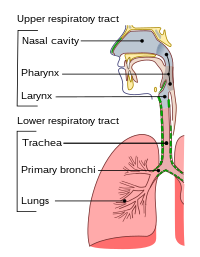
Photo from wikipedia
Prompt detection of viral respiratory pathogens is crucial in managing respiratory infection including severe acute respiratory infection (SARI). Metagenomics next‐generation sequencing (mNGS) and bioinformatics analyses remain reliable strategies for diagnostic… Click to show full abstract
Prompt detection of viral respiratory pathogens is crucial in managing respiratory infection including severe acute respiratory infection (SARI). Metagenomics next‐generation sequencing (mNGS) and bioinformatics analyses remain reliable strategies for diagnostic and surveillance purposes. This study evaluated the diagnostic utility of mNGS using multiple analysis tools compared with multiplex real‐time PCR for the detection of viral respiratory pathogens in children under 5 years with SARI. Nasopharyngeal swabs collected in viral transport media from 84 children admitted with SARI as per the World Health Organization definition between December 2020 and August 2021 in the Free State Province, South Africa, were used in this study. The obtained specimens were subjected to mNGS using the Illumina MiSeq system, and bioinformatics analysis was performed using three web‐based analysis tools; Genome Detective, One Codex and Twist Respiratory Viral Research Panel. With average reads of 211323, mNGS detected viral pathogens in 82 (97.6%) of the 84 patients. Viral aetiologies were established in nine previously undetected/missed cases with an additional bacterial aetiology (Neisseria meningitidis) detected in one patient. Furthermore, mNGS enabled the much needed viral genotypic and subtype differentiation and provided significant information on bacterial co‐infection despite enrichment for RNA viruses. Sequences of nonhuman viruses, bacteriophages, and endogenous retrovirus K113 (constituting the respiratory virome) were also uncovered. Notably, mNGS had lower detectability rate for severe acute respiratory syndrome coronavirus 2 (missing 18/32 cases). This study suggests that mNGS, combined with multiple/improved bioinformatics tools, is practically feasible for increased viral and bacterial pathogen detection in SARI, especially in cases where no aetiological agent could be identified by available traditional methods.
Journal Title: Journal of Medical Virology
Year Published: 2023
Link to full text (if available)
Share on Social Media: Sign Up to like & get
recommendations!